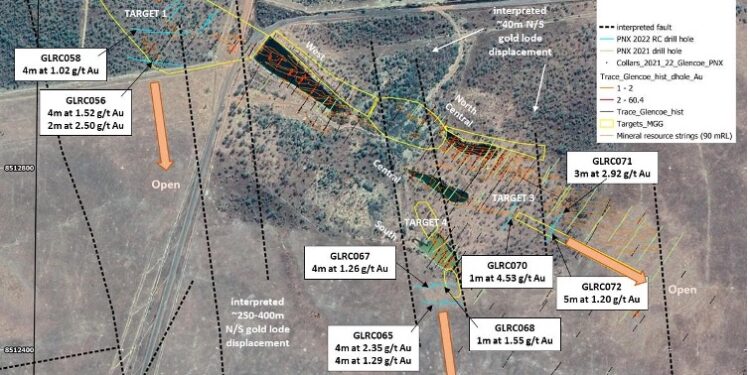PNX Metals Limited (ASX: PNX) has received positive gold assay results from its recently completed reverse circulation (RC) drilling programme at the Glencoe gold deposit in Australia’s Northern Territory.
The programme comprised 18 RC drill holes for a total of 1,740 metres, and was successful in demonstrating continuity to the east of the Central Zone by approximately 200 metres, and that the gold-bearing quartz veins previously reported at surface extends at depth and to the south, oblique to the main gold mineralization.
Glencoe currently hosts a Mineral Resource Estimate (MRE) of 2.1 Mt @ 1.2 g/t Au for 79,000 oz Au (77.4% Measured and Indicated Categories) reported in accordance with the 2012 JORC Code and is located on a granted Mineral Lease approximately 170 km south of Darwin, and three km north of PNX’s Fountain Head Gold Project development in the Pine Creek region of the Northern Territory.
“The gold results from our recent RC drilling, in conjunction with interpretation of the recent drone magnetic survey, provide confidence that further gold mineralisation exists outside of the defined Mineral Resource shell at Glencoe,” Managing Director James Fox said.
“The successful drilling of gold-bearing quartz veins trending north-south supports the larger-scale interpretation of a mineralized corridor extending between Glencoe and Fountain Head. We look forward to testing these targets as soon as possible.
“The latest RC drilling at Glencoe has successfully intersected gold mineralization outside of the existing MRE and extended the strike extent of Central mineral lode to the SE along the Glencoe anticline by approximately 200 metres.
“The delineation of gold mineralisation with a new north-south geometry unlocks the potential for resources beyond those currently estimated, which typically followed the NW/SE-trending anticline, and opens up a significant new zone between Glencoe and the Fountain Head gold project three km to the south.”
Several approximately north-south-trending faults, identified by the detailed drone-mag survey interpreted to cut through the Glencoe area and appear to displace the host geology and the main fold-related gold lodes by approximately 40 metres. A fault with a displacement of between 250- 400 metres is interpreted immediately west of the West Pit.
The importance of these north-south faults is to be investigated to determine their influence on the location and possible displacement of the known high-grade gold domains.
Summary of Results and Interpretation
The Glencoe RC drill program successfully tested Targets 1, 3 and 4 where:
• near-surface gold anomalism highlighted along-strike potential from the current (MRE)
• gold-bearing quartz veins oblique to the main gold lodes were identified by surface rock chip samples including: 33.1 g/t Au in GLFS035c; 15.5 g/t Au in GLFS043; 35.8 g/t Au in GLFS046a, and 15.9 g/t Au in GLFS046c.
Next Steps
The area between Glencoe and Fountain Head, three km to the south, is highly prospective for new gold mineralisation. Due to the presence of transported shallow cover, Rotary Air Blast drilling will be used to obtain broad-spaced geochemical information which can then be used to further target zones of interest.
The potential exists for additional anticline-hosted mineralisation similar to that at both the Glencoe and Fountain Head gold deposits, and new north-south trending mineralisation associated with gold-bearing sheeted quartz veins.
For further information please visit: https://pnxmetals.com.au/












